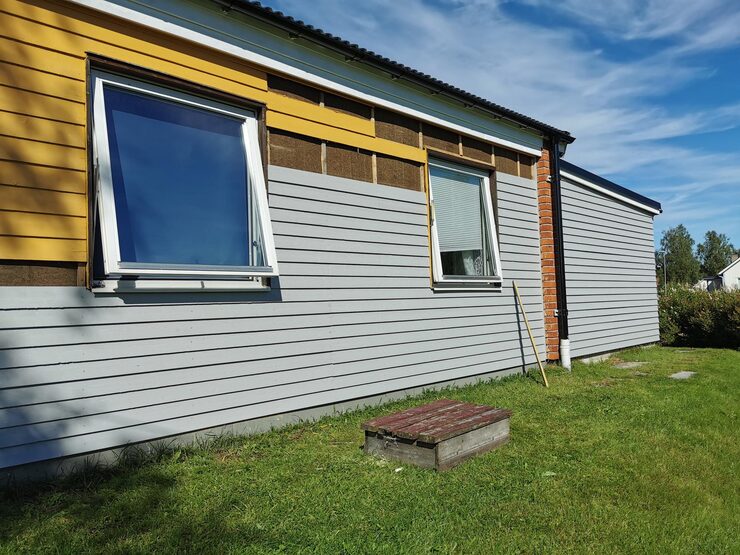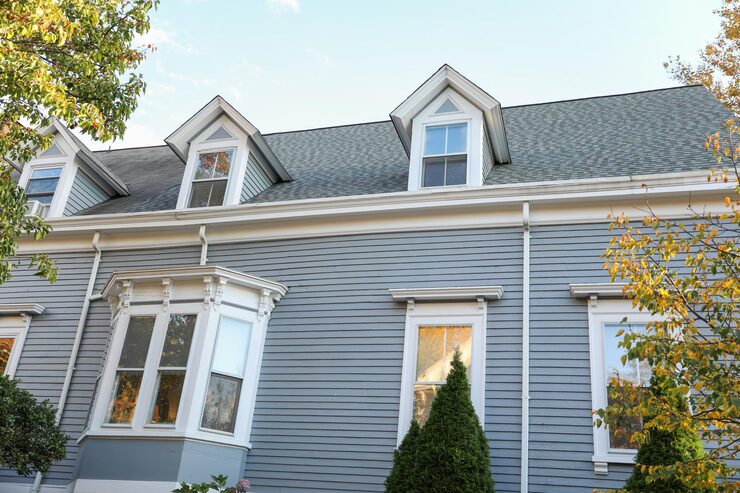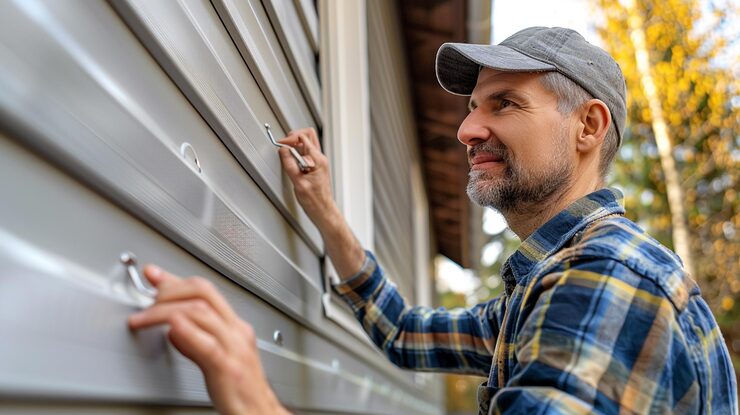
Table of Contents
Key Takeaways
✔ Vinyl siding typically lasts 30–40 years, and with proper care, it can exceed 60 years.
✔ Shaded areas reduce UV damage, helping extend how long vinyl siding lasts.
✔ Excess shade can increase moisture retention, leading to mold or mildew growth.
✔ Regular cleaning preserves appearance and protects siding from long-term damage.
✔ Knowing how to tell when vinyl siding needs to be replaced prevents costly repairs.
✔ Damaged panels can be repaired or replaced without removing the entire wall.
✔ Proper installation and quality materials directly affect how long vinyl siding lasts.
✔ Routine inspections help catch hidden damage behind vinyl siding before it spreads.
Vinyl siding is known for its durability, low maintenance, and long-lasting curb appeal. However, its lifespan can vary widely depending on where it’s installed and how it’s maintained. While manufacturers often provide broad estimates for how long vinyl siding lasts, real-world performance is shaped by climate, installation quality, and exposure to the elements.
Here are six factors every homeowner should consider when evaluating whether shade will help or hinder vinyl siding’s longevity.

How Long Does Vinyl Siding Last?
On average, vinyl siding remains in good condition for 30 to 40 years, but with consistent upkeep and timely repairs, it can last well over 60 years before a full replacement is necessary.
Factors such as climate, installation quality, and maintenance frequency all determine how long vinyl siding lasts on any given home. Regular cleaning, prompt attention to cracks or warping, and protection from extreme sun exposure can extend its lifespan significantly.
Understanding these variables not only helps set realistic expectations but also makes it easier to recognize how long vinyl siding last and when it needs to be replaced before small issues lead to costly structural damage.

How Shade Impacts the Lifespan of Vinyl Siding
1. Reduced UV Damage
Direct sunlight is one of the biggest threats to vinyl siding, breaking down its surface over time and causing colors to fade. Shaded areas can help slow this process, but homeowners still need to understand that shade alone does not guarantee a longer lifespan. When evaluating how long vinyl siding lasts, it’s important to balance the benefits of reduced sun exposure with other environmental factors like moisture and airflow.
How Shade Minimizes UV-Related Wear
- Lowers Risk of Color Fading: Without constant exposure to UV rays, the pigments in vinyl siding hold their color longer, maintaining the home’s visual appeal. This can make a noticeable difference over decades, potentially extending how long vinyl siding lasts compared to panels in full sun.
- Less Heat-Related Warping: Sunlight heats vinyl siding, causing expansion and contraction that may warp panels over time. Shade helps regulate temperature swings, which can preserve panel alignment and slow down the breakdown of the siding’s structure.
- Reduces Surface Brittleness: Long-term sun exposure can make vinyl brittle, increasing the risk of cracking when panels are impacted or during extreme cold. Shaded siding retains more flexibility, which contributes to its ability to last closer to the upper range of how long vinyl siding lasts in most climates.
2. Lower Heat Stress
Extreme temperature swings can shorten siding’s life by causing repeated expansion and contraction. In shaded areas, vinyl experiences more stable temperatures, which helps prevent the fine stress lines that eventually weaken the panels. When considering how long is vinyl siding likely to remain structurally sound, reduced heat stress is a major advantage that can keep siding in good condition for decades.
How Cooler Conditions Protect Vinyl Siding
- Fewer Thermal Expansion Gaps: Excessive heat can cause vinyl to expand, pulling at fasteners and creating small gaps along seams. Shade helps keep panels within a stable temperature range, reducing the risk of visible gaps that may let moisture seep in.
- Improves Fastener Integrity: Metal nails or screws can loosen over time due to constant movement from heat cycles. By limiting those cycles, shaded siding holds its fasteners more securely, which helps extend how long vinyl siding lasts.
- Less Frequent Panel Adjustments: Siding in direct sun may need more frequent alignment corrections to avoid buckling. Cooler conditions help panels remain straight and even for longer periods.
3. Reduced Color Distortion Over Time
While fading is common knowledge, uneven color distortion is another concern that affects a home’s appearance. Shaded siding generally maintains its original tone better, avoiding the patchy look that sometimes develops on sunny façades. Knowing this can help homeowners decide when vinyl siding needs to be replaced for aesthetic reasons, not just structural ones.
How Shade Supports Long-Term Color Consistency
- Balanced Weathering: Siding panels in constant sunlight may lighten faster, creating visual differences between sunlit and shaded walls. If most of the home’s exterior is shaded, the color will age more uniformly.
- Preserved Gloss and Finish: High heat and UV light can dull the sheen of vinyl, making it look older before its time. Shade slows down this loss of finish, keeping the exterior looking newer for longer.
- Better Match for Future Repairs: When replacements are needed, shaded siding is more likely to match the original tone, making spot repairs less noticeable.
4. Less Risk of Heat-Induced Warping
Warping can occur when vinyl overheats, especially on walls facing south or west. Shaded areas are far less likely to reach those high surface temperatures, which helps maintain panel shape. This stability plays a big role in determining how long vinyl siding lasts before it needs full replacement.
How Shade Prevents Warping Issues
- Stable Panel Structure: Without excessive heat, vinyl panels stay flatter and resist curling at the edges. This means fewer structural distortions that could lead to water penetration.
- No Overheating from Reflected Sunlight: Nearby pavement or windows can reflect intense sunlight onto siding, sometimes melting it. Shade blocks these hot spots, protecting siding from severe surface damage.
- Less Stress on Seams: Warped panels often place pressure on connecting seams, which can cause cracks. Shade reduces the likelihood of these stress points forming.
5. Longer Seal and Caulk Life
Caulk and sealants used around windows, doors, and trim can break down faster when exposed to direct heat. Shaded areas protect these components, ensuring a tighter weather seal over time. This added protection not only extends how long is vinyl siding able to shield the home but also reduces maintenance costs.
How Shade Helps Maintain Weatherproofing
- Slower Sealant Dry-Out: UV and heat make caulk brittle, causing it to shrink or peel away. Shade keeps caulking flexible for a longer period, improving its ability to block moisture.
- Better Adhesion Over Time: Cooler temperatures help sealants grip surfaces without early breakdown, maintaining a strong bond between siding and trim.
- Fewer Drafts and Leaks: When seals hold longer, the home stays better insulated and protected from wind-driven rain.
6. Improved Comfort and Energy Efficiency
Although siding’s main purpose is protection, its condition can also influence indoor comfort. By keeping temperatures more stable, shaded vinyl siding can contribute to a cooler home in the summer. Over time, this stability can factor into decisions about how to replace vinyl siding when upgrading for both aesthetics and efficiency.
How Shade Enhances Overall Performance
- Reduced Heat Transfer: Shaded siding absorbs less heat, which can keep wall cavities cooler and lower the strain on cooling systems.
- Lower Expansion Noise: In direct sun, expanding vinyl can make popping or creaking sounds as it shifts. Shade limits these noises, providing a quieter indoor environment.
- Potential Energy Bill Savings: While siding is not insulation, its ability to moderate surface temperature can support energy efficiency goals, especially when paired with insulated panels.
How to Clean Vinyl Siding Without Causing Damage
Vinyl siding remains one of the most popular exterior cladding materials in the U.S., accounting for about 25.6% of the market share for new single-family homes as of 2023. Keeping it clean is essential for maintaining both its appearance and longevity. Over time, dirt, mildew, and environmental debris can build up—especially in shaded areas where moisture lingers—so knowing the right cleaning techniques helps preserve the finish, reduce wear, and extend its lifespan.
1. Use a Gentle Cleaning Solution
Mild soap or a vinegar-and-water mix works well for removing grime without stripping the finish. Harsh chemicals can degrade the surface, shortening how long vinyl siding lasts in the long run. Always test a small area first to ensure no discoloration occurs.
2. Apply Soft-Bristle Brushes or Cloths
A soft-bristle brush loosens dirt without scratching the surface, making it a safer choice than abrasive tools. Gentle pressure helps maintain the siding’s color and finish. This simple step can help extend how long vinyl siding is expected to look new.
3. Rinse With Low-Pressure Water
While pressure washers can be tempting, high settings may crack or loosen panels. Instead, use a garden hose or set the washer to its lowest setting to avoid damage. Low-pressure rinsing is a safe method for homeowners who want to protect how long vinyl siding lasts.
4. Work From the Bottom Up
Starting from the bottom prevents streaking and ensures dirt and soap do not run onto already cleaned areas. This method also helps control water flow and avoids forcing moisture behind panels. Such care can make a noticeable difference in how long vinyl siding lasts in both sunny and shaded spots.
5. Schedule Seasonal Cleanings
Cleaning twice a year—once in spring and again in fall—helps keep siding free from buildup. Regular care reduces the need for repairs and improves one’s ability to tell when vinyl siding needs to be replaced. Consistency in upkeep can extend the siding’s lifespan significantly.
6. Avoid Cleaning in Direct Sunlight
Washing vinyl siding in direct sunlight can cause the cleaning solution to dry too quickly, leaving streaks or residue. Cleaning in the shade ensures even drying and protects the surface finish. This simple timing adjustment can help extend how long vinyl siding lasts by preventing unnecessary wear. It also makes the cleaning process more efficient, requiring less scrubbing and rinsing.

How to Check for Hidden Damage Behind Vinyl Siding
Even when vinyl siding looks fine from the outside, hidden damage can develop underneath due to trapped moisture, pests, or structural wear. Identifying these issues early can help extend how long vinyl siding lasts and prevent costly repairs. A careful inspection ensures the siding continues to protect the home for as long as possible.
1. Inspect for Soft Spots on the Surface
Press gently on various panels to check for areas that feel soft or spongy. Soft spots often indicate rotting sheathing or moisture damage hidden behind the siding. Detecting these early can prevent the need for full replacement before how long vinyl siding’s lasts reaches its potential. Early intervention here can save thousands in repair costs.
2. Look for Warping or Buckling Panels
Warped or buckled panels can signal that water is trapped beneath the surface. Over time, this trapped moisture can cause significant structural damage. Correcting the problem quickly can protect how long vinyl siding lasts in both sunny and shaded areas. Addressing warping fast helps avoid damage to the underlying walls.
3. Check Seams and Joints for Gaps
Gaps between panels or at corners may allow rainwater and pests to enter. Even small openings can lead to damage that shortens how long vinyl siding is expected to perform. Regularly inspecting these areas keeps the siding’s protective barrier intact. A tight seal is your best defense against moisture and insects.
4. Examine Around Windows and Doors
Water intrusion often starts near openings where flashing or caulk has failed. If left unchecked, the underlying materials can deteriorate long before how to tell when vinyl siding needs to be replaced becomes obvious from the exterior. Re-caulking or replacing flashing can stop the issue from spreading. Keeping these areas sealed ensures the rest of the siding stays protected.
5. Look for Signs of Pest Activity
Insects, birds, and rodents can sometimes nest behind siding, especially in shaded, protected areas. Droppings, gnaw marks, or small holes may be early signs of an infestation. Addressing pests promptly is essential to preserving how long vinyl siding lasts. Unchecked infestations can destroy structural components in months, not years.
6. Use a Moisture Meter for Hidden Leaks
A moisture meter can detect water presence that isn’t visible to the naked eye. High readings indicate the need for further inspection or repairs. Taking this step can extend how long vinyl siding lasts by ensuring no lingering water weakens the structure. It’s a simple tool that can reveal costly problems before they worsen.
Frequently Asked Questions
What is the main problem with vinyl siding?
The main problem with vinyl siding is its vulnerability to cracking, warping, or fading when exposed to extreme weather over time. While it can last decades, improper installation or lack of maintenance can shorten how long vinyl siding lasts. Moisture trapped behind panels can also lead to hidden structural damage. Regular inspections and cleaning help prevent these issues.
At what temperature does vinyl become brittle?
Vinyl siding can start to become brittle at temperatures below 40°F, making it more susceptible to cracking on impact. In colder climates, this can shorten how long vinyl siding lasts if not maintained properly. Scheduling repairs during milder weather can help avoid breakage. Choosing high-quality panels can improve cold-weather performance.
Can damaged vinyl siding be replaced?
Yes, damaged vinyl siding panels can be replaced without removing the entire wall. Knowing how to replace vinyl siding correctly ensures a seamless repair that blends with existing panels. Timely replacement of broken sections helps extend the overall lifespan of the siding. It also prevents moisture intrusion that can cause further damage.
Can vinyl siding be removed and put back on?
Vinyl siding can be carefully removed and reinstalled if repairs or insulation work are needed. However, the process requires skill to avoid cracking brittle panels or misaligning seams, which could reduce how long is vinyl siding able to protect the home. Using the proper tools, such as a zip tool, makes the process safer. Professional help is often recommended for large sections.
What are the steps of replacing siding?
Replacing vinyl siding involves removing the old panels, inspecting the underlying structure, installing weather barriers, and fitting new panels securely. Understanding how to replace vinyl siding also means ensuring proper alignment and securing seams to prevent water infiltration. The process ends with reinstalling trim and checking for gaps. Done correctly, this can extend how long vinyl siding lasts for decades.

Protect and Upgrade Your Home with Lyndsey Roofing, LLC!
At Lyndsey Roofing, LLC, our team takes pride in delivering expert roofing services that keep Poughkeepsie homes safe, beautiful, and built to last. From precision roof repairs to full installations, we handle every project with craftsmanship, attention to detail, and materials that stand up to the toughest weather. Homeowners in Poughkeepsie, NY, count on us for honest communication, dependable timelines, and results that not only protect but also enhance curb appeal.
If it’s time to strengthen your roof and invest in lasting protection, our crew is ready to make it happen. Contact us today!







